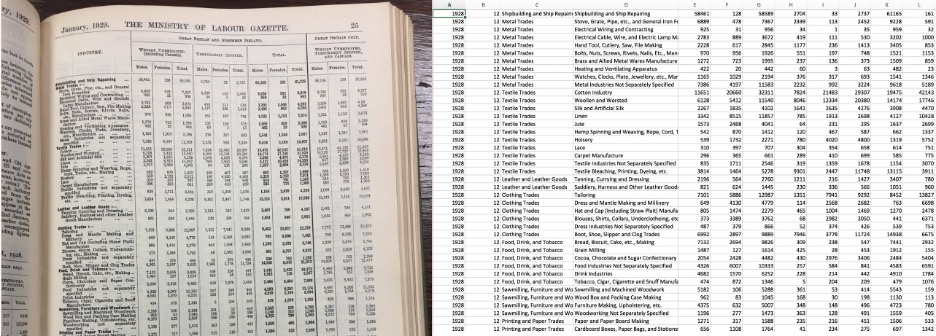Industrial, regional, and gender divides in British unemployment between the wars
By Meredith M. Paker (Nuffield College, Oxford)
This blog is part of a series of New Researcher blogs.
—

‘Sometimes I feel that unemployment is too big a problem for people to deal with … It makes things no better, but worse, to know that your neighbours are as badly off as yourself, because it shows to what an extent the evil of unemployment has grown. And yet no one does anything about it’.
A skilled millwright, Memoirs of the Unemployed, 1934.
At the end of the First World War, an inflationary boom collapsed into a global recession, and the unemployment rate in Britain climbed to over 20 per cent. While the unemployment rate in other countries recovered during the 1920s, in Britain it remained near 10 per cent for the entire decade before the Great Depression. This persistently high unemployment was then intensified by the early 1930s slump, leading to an additional two million British workers becoming unemployed.
What caused this prolonged employment downturn in Britain during the 1920s and early 1930s? Using newly digitized data and econometrics, my project provides new evidence that a structural transformation of the economy away from export-oriented heavy manufacturing industries toward light manufacturing and service industries contributed to the employment downturn.
At a time when few countries collected any reliable national statistics at all, in every month of the interwar period the Ministry of Labour published unemployment statistics for men and women in 100 industries. These statistics derived from Britain’s unemployment benefit program established in 1911—the first such program in the world. While many researchers have used portions of this remarkable data by manually entering the data into a computer, I was able to improve on this technique by developing a process using an optical-character recognition iPhone app. The digitization of all the printed tables in the Ministry of Labour’s Gazette from 1923 through 1936 enables the econometric analysis of four times as many industries as in previous research and permits separate analyses for male and female workers (Figure 1).

This new data and analysis reveal four key findings about interwar unemployment. First, the data show that unemployment was different for men and women. The unemployment rate for men was generally higher than for women, averaging 16.1 percent and 10.3 per cent, respectively. Unemployment increased faster for women at the onset of the Great Depression but also recovered quicker (Figure 2). One reason for these distinct experiences is that men and women generally worked in different industries. Many unemployed men had previously worked in coal mining, building, iron and steel founding, and shipbuilding, while many unemployed women came from the cotton-textile industry, retail, hotel and club services, the woolen and worsted industry, and tailoring.

Second, regional differences in unemployment rates in the interwar period were not due only to the different industries located in each region. There were large regional differences in unemployment above and beyond the effects of the composition of industries in a region.
Third, structural change played an important role in interwar unemployment. A series of regression models indicate that, ceteris paribus, industries that expanded to meet production needs during World War I had higher unemployment rates in the 1920s. Additionally, industries that exported much of their production also faced more unemployment. An important component of the national unemployment problem was thus the adjustments that some industries had to make due to the global trade disturbances following World War I.
Finally, the Great Depression accelerated this structural change. In almost every sector, more adjustment occurred in the early 1930s than in the 1920s. Workers were drawn into growing industries from declining industries, at a particularly fast rate during the Great Depression.
Taken together, these results suggest that there were significant industrial, regional, and gender divides in interwar unemployment that are obscured by national unemployment trends. The employment downturn between the wars was thus intricately linked with the larger structural transformation of the British economy.
—
Meredith M. Paker
meredith.paker@nuffield.ox.ac.uk
Twitter: @mmpaker

